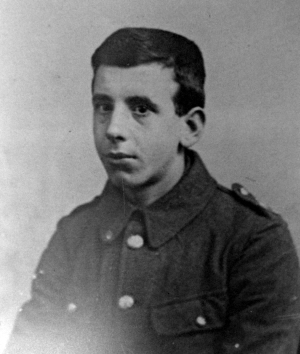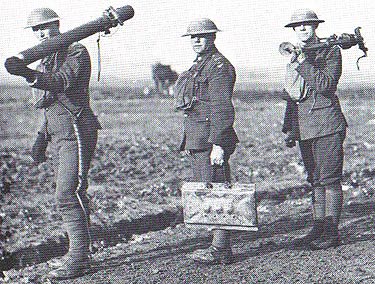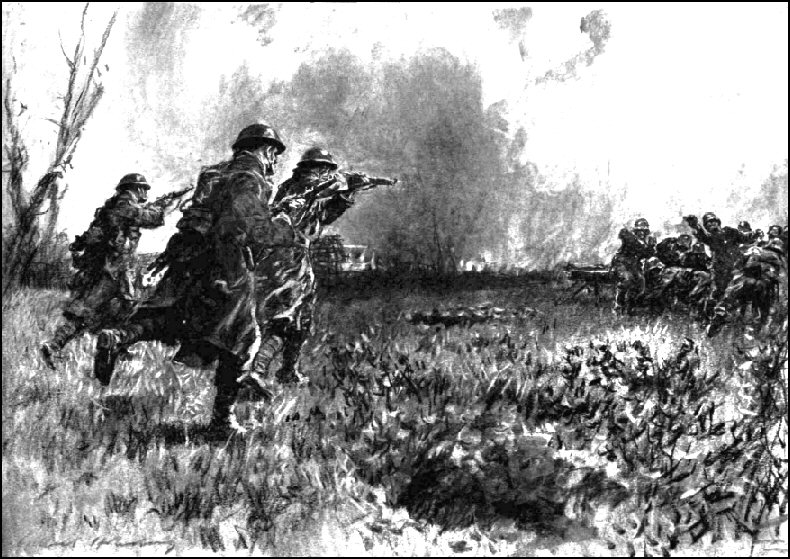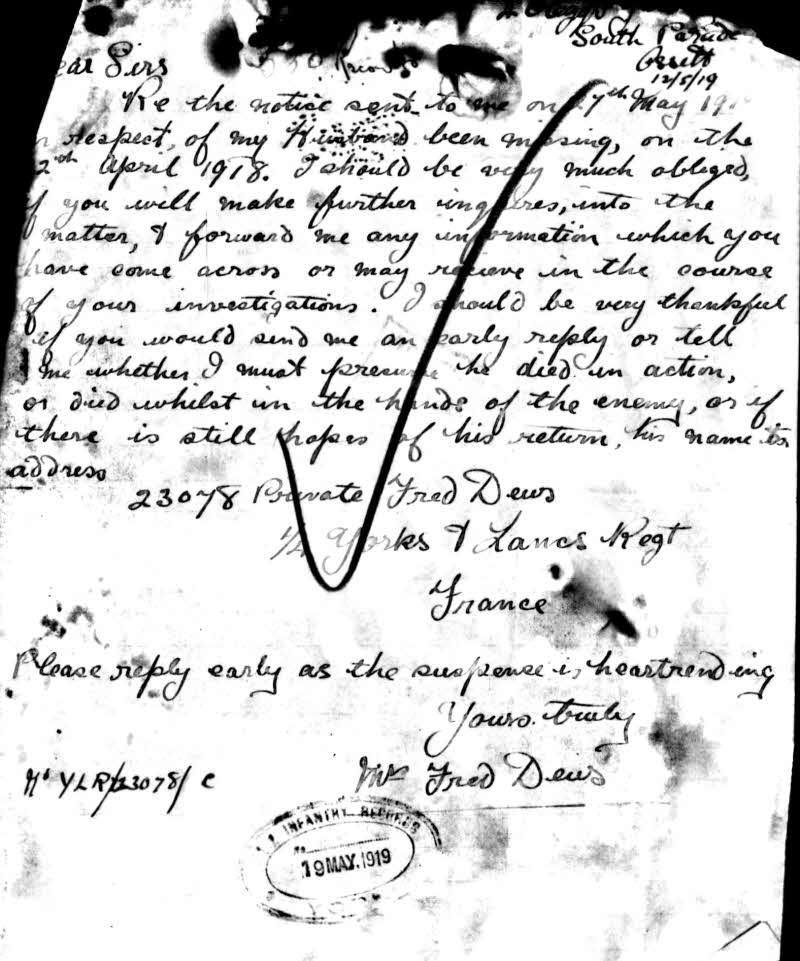
Fred Dews was born in Ossett in October 1891, the youngest of eight children born to James Dews and Mary Harriet Dews, who were married on the 4th January 1873 at Wellington Rd. Chapel, Dewsbury. Mary Harriet Dews was the daughter of Edward Dews who built Whinfield Terrace, Spa Street, Ossett where James Dews and his family lived. Edward Dews also built the Fleece public house and Dews Row, both in Ossett.
By 1911, Fred was working as a miner and living at 51, Cliff View, Denaby, near Doncaster with his elder brother William Dews, who was a deputy in a coal mine. James Dews, Fred’s father was working as a Corporation road man in 1913.
On the 25th January 1913, at South Ossett Parish Church, 21 year-old Fred Dews, miner, living at Ossett Common married 19 year-old Sarah Hannah Ellis of South Parade, Ossett, daughter of Walter Ellis, a miner. Shortly afterwards, the couple had a son, Walter Arthur Dews born in Ossett on the 18th February 1913. They had a second son, Frederick Dews who was born on the 7th December 1914, but who died on the 5th March 1915.
The 1st/4th (Hallamshire) Battalion of the York and Lancaster Regiment was formed at Sheffield in August 1914. Fred Dews enlisted at Pontefract on the 11th August 1915 in the 1/4th (Hallamshire) Battalion so he was a volunteer. He was medically examined on the 10th August 1915: height 5’ 6″, weight 117 lbs, 36 inch chest with no marks or defects. Pale complexion, brown eyes, dark brown hair. His denomination was recorded as “Baptist or Congregationalist”. Fred Dews was training at Farnley Tank Camp, Otley on the 24th August 1915. From Farnley, he moved to Rugeley where his army record reveals a number of unauthorised absences:
Fred Dews was finally posted on the 15th March 1916, embarking from Folkstone the same day. By the 29th March 1916, he joined his Battalion in the field.
Private Dews was a Stokes Gunner and part of a three-man team who carried and manned the gun. The Stokes mortar was designed to answer the need for a mobile and quick firing trench mortar. The gun was simplicity itself. A 51 in. long, 3 in. diameter barrel was supported by a bipod and sat on a base plate. The Stokes was fired by dropping an 11lb shell down the tube onto a firing pin at the base of the tube. This set off a shotgun-like blank cartridge and this in turn ignited propellant rings attached to the mortar shell. The angle of the bipod could be adjusted to increase or decrease the range and the shell could be fired to a maximum range of 800 yards. The safe minimum distance was 100 yards. The Stokes mortar would become an essential element in the BEF’s arsenal as more experience was gained in its use.1

Above: Stokes Mortar Team in WW1.
Fred Dews gave his next of kin as his wife, Sarah Ann Dews, 4 Cleggs Yard, Ossett, suggesting she may have returned to Ossett for the duration of the War.
Before Fred Dews joined, the regiment had first landed in Boulogne on the 14th April 1915 and by the 15th May 1915, the formation became 148th Brigade, 49th (West Riding) Division.
Private Fred Dews was killed in action on the 12th April 1918, aged 26, most probably in the defence of Neuve-Eglise, part of the Battle of Hazebrouck, 12th – 15th April 1918. The 148th Brigade, 49th (West Riding) Division were heavily involved in the bitter fighting as the Germans tried to break through. They lost three officers killed, three other ranks killed, 76 wounded and 72 missing on the 12th April, including Private Fred Dews.
On Friday the 12th of April 1918, the Germans had got over the Lys at Merville and had reached to outskirts of the Forest of Nieppe in front of the town of Hazebrouk, however a fierce resistance put up by the British 31st division had denied both the forest and the town to the enemy. During that day the Germans had also begun a new thrust towards Mount Kemmel in the south of the Ypres Sector. The greatest weight had been thrown at the defences in front of Neuve Eglise.

Above: Fighting at Neuve Eglise in April 1918.
Before WW1, Neuve Eglise (now called Nieuwkerke), was an insignificant Belgian village to the north of Armentieres, on the road leading to the town of Kemmel. In April 1918, at this crucial stage of the war on the Western Front, the village had been defended by elements of the 148th (3rd West Riding) Brigade of the Territorial 49th (West Riding) Division, consisting of the 1st/4th Battalion of the King’s Own Yorkshire Light Infantry and the 1st/4th (Hallamshire) Battalion of the York and Lancaster Regiment, in company with the 2nd Worcesters, the Brigade, in trenches to the north of the village, had been under constant enemy artillery bombardment and enemy infantry harassment throughout the eleventh of April and early the next day the Germans had launched a concentrated infantry attack which had succeeded in forcing an entry into the southern part of the village.
Ejected from their positions by this assault, during the early hours of the following day, Saturday the 13th of April, the West Yorkshiremen together with the Worcesters, had mounted a counter attack ‘with great spirit’, which after a ferocious bout of street fighting, had managed to drive the enemy out of the village and back some 150 yards or more, the K.O.Y.L.I. capturing seventeen German infantrymen in the village Y.M.C.A. in the process.2
Fred Dews is remembered at the Tyne Cot Memorial 3, Zonnebeke, West-Vlaanderen, Belgium on Panel 125 – 128. The Tyne Cot Memorial is one of four memorials to the missing in Belgian Flanders which cover the area known as the Ypres Salient. Broadly speaking, the Salient stretched from Langemarck in the north to the northern edge in Ploegsteert Wood in the south, but it varied in area and shape throughout the war. The Tyne Cot Memorial now bears the names of almost 35,000 officers and men whose graves are not known.
Hannah Dews of 4 Clegg’s Yard, South Parade, Ossett was awarded a pension of 20s 5d a week for her and her son from the 30th December 1918.

Above: Hannah sent a letter on the 12th May 1919 seeking any additional information regarding the whereabouts of her missing husband Private Fred Dews.
“Dear Sirs,
Re the notice sent to me on the 7th May 1919 in respect of my Husband been missing on the 12th April 1918. I should be very much obliged if you would make further inquiries into the matter, & forward me any information which you have come across or may receive in the course of your investigations. I should be very thankful if you could send me an early reply or tell me whether I should presume he died in action or died whilst in the hands of the enemy, or if there is still hope of his return. His name & address
23078 Private Fred Dews, 1/4 Yorks & Lancs Regiment, France.
Please reply early as the suspense is heartrending.
Yours Truly
Mrs Fred Dews.”
Remarkably, Fred Dews had previously been in the Army and had been discharged as unfit. His earlier service record reads as follows:
“Attested 9/11/1914 at Pontefract, had a medical when he was declared fit for the Army and was mobilised the same day. Posted on 24/11/14 no. 19576, KOYLI aged 23 and living at Denaby, but born Ossett.”
Fred Dews was subsequently discharged on the 5th May 1915, having served for just 117 days and was “at home” for the whole period. His character on discharge was “good” and his address was 51, Cliff View, Denaby. He had a medical on the 9th November 1914 when he was declared fit for the Army.
However, on the 17th February 1915, he was examined again at Harrogate and discharged on the basis “not likely to become an efficient soldier”. He was diagnosed with Hammer Toes and Hallux Valgus (i.e. a bunion). When he was at Harrogate, his conduct record shows:
It’s pretty clear that Fred Dews made some bad decisions in his life. His biggest mistake was re-signing and returning from all of his many absences. It was to prove fatal.
In 1920, Fred Dews’ widow Sarah Hannah Dews married Thomas Benton in the Dewsbury registration district. Sadly, Sarah died in early 1931 at the early age of 37 years, but her second husband Thomas Benton was still living at 4, Clegg’s Yard, South Parade, Ossett in 1961, the same house that Sarah Hannah Dews lived when her husband Fred was killed in WW1.
References:
2. Neuve Eglise 1918 – World War One (from the book “Neath a Foreign Sky” by Paul Allen)